Search
Search for "click":
(Click here to search this entire website for "click" with Google.)
 |
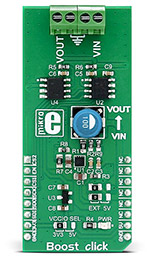
|
|
Use our new boost converter to step up the voltage in your next project.
Boost click carries Microchip's MIC2606, a 2MHz, PWM DC/DC boost switching regulator available in a 2mm x 2mm MLF® package.
Boost click provides an adjustable output voltage through the onboard DAC that drives the FB pin of the MIC2606 to set desired output voltage. The click also has an onboard ADC that converts output voltage and sends its digital value through SPI pins of mikroBUS™ to the microcontroller. |
|
|
|
 |
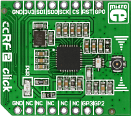
|
|
ccRF2 click carries CC1120, the fully integrated, high-performance single-chip radio transceiver with extremely low power consumption. Designed mainly for the ISM (Industrial, Scientific, and Medical) and SRD (Short Range Device) frequency bands at 164–192 MHz, 274–320 MHz, 410–480 MHz, and 820–960 MHz, CC1120 provides extensive hardware support for packet handling, data buffering, burst transmissions, clear channel assessment, link quality indication, and Wake-On-Radio. It also has exceptional receiver sensitivity. ccRF2 click communicates with the target board through mikroBUS SPI (MISO, MOSI, CSK), and AN, RST, CS, PWM and INT lines. The board is designed to use a 3.3V power supply. |
|
|
|
 |
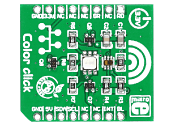
|
|
Color click is a compact and easy solution for adding color sensing to your design. It features a TCS3471 color light sensor as well as an RGB LED diode. The TCS3471 features red, green, blue, and clear light sensing (RGBC) that detects light intensity under a variety of lighting conditions and through a variety of attenuation materials. An RGB LED is provided to help you illuminate the objects if no other light source is available. Color click communicates with the target board microcontroller via mikroBUS I2C (SDA, SCL) and INT lines. The board is designed to use 3.3V power supply only. |
|
|
|
 |
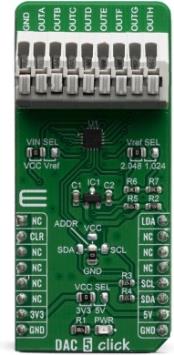
|
|
DAC 5 Click carries Texas Instruments DAC53608 IC, a low-power, eight-channel, 10-bit buffered Digital-to-Analog Converter. DAC53608 converts digital value to the corresponding voltage level using external voltage reference. For that purpose, DAC 5 click uses MAX6106, which is a low-dropout micropower voltage reference with 2,048V output voltage. With all those possibilities on board, DAC 5 click makes a perfect choice for an accurate and simple generation of analog signals for various purposes, such as programmable Power Supplies, Laser Drivers, Projectors, IP Network cameras, auto focus digital still camera lens, and more.
DAC 5 click board™ is supported by a mikroSDK compliant library, which includes functions that simplify software development. This Click board™ comes as a fully tested product, ready to be used on a system equipped with the mikroBUS™ socket.
|
|
|
|
 |
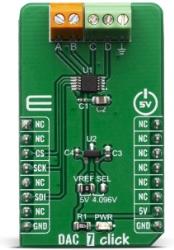
|
|
DAC 7 click carries the AD5624R, a low-power four-channel, 12-bit buffered Digital-to-Analog Converter from Texas Instruments. AD5624R converts digital value to the corresponding voltage level using external voltage reference. This will help you convert digital information from the main board to four analog outputs on the DAC 7 click. For that purpose, DAC 7 click uses MCP1541, which is a low-dropout precision voltage reference with 4.096V output voltage. With all those possibilities on board, DAC 7 click makes a perfect choice for an accurate and simple generation of analog signals for various purposes, such as programmable Power Supplies, Laser Drivers, Projectors, IP Network cameras, auto focus digital still camera lens, and more.
DAC 7 click board™ is supported by a mikroSDK compliant library, which includes functions that simplify software development. This Click board™ comes as a fully tested product, ready to be used on a system equipped with the mikroBUS™ socket.
|
|
|
|
 |

|
|
Track the patterns of your beating heart with ECG 2 click. ECG 2 click contains ADS1194 16-bit delta-sigma analog-to-digital converters from Texas Instruments, a built-in programmable gain amplifier (PGA), an internal reference, and an onboard oscillator. |
|
|
|
 |
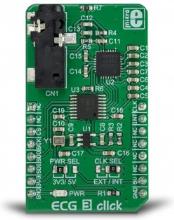
|
|
ECG 3 click is a complete solution for the development of ECG applications, which utilizes a specialized clinical-grade biopotential analog front-end (AFE) IC. ECG click uses the MAX30003 IC, an ultra-low power, single channel, integrated biopotential AFE, which features a wide range of options, making it a universal solution for many different types of ECG applications. ECG 3 click is an ideal solution for the development of heart rate monitoring applications, fitness applications, for the ECG bio-authentication, and similar applications.
It comes in the package which also includes the mikroSDK™ software and a library with all the functions. The Click board™ comes as a fully tested and approved prototype, making it a reliable device ready to use on the development board.
|
|
|
|
 |
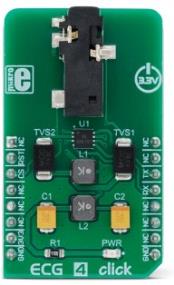
|
|
ECG 4 Click is a complete solution for the development of ECG and Heart-Rate (HR) applications, based on the BMD101, a specialized bio-signal sensing System-on-Chip (SoC). ECG 4 click offers a reliable and accurate ECG and heart-rate monitoring, by sending processed bio-data over the UART interface. Its interface offers great flexibility and thus, very simple integration into any development environment. Besides the highly specialized bio-sensing SoC, ECG 4 click is equipped with the 3.5mm electrodes connector, as well as with ESD protection diodes, making it ready to be used out of the box.
ECG 4 Click is supported by a mikroSDK compliant library, which includes functions that simplify software development. This Click board™ comes as a fully tested product, ready to be used on a system equipped with the mikroBUS™ socket.
|
|
|
|
 |
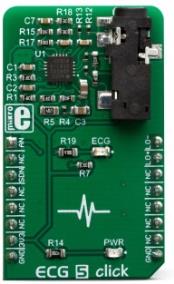
|
|
ECG 5 click can be used for the development of ECG and Heart-Rate (HR) applications. The Click board™ features the AD8232, an integrated bio-signal front end. This IC has many features necessary for providing accurate ECG measurements, including very high common-mode rejection ratio, high gain with DC blocking capability, adjustable high-pass and low-pass filters, integrated right leg drive (RLD), etc. Electrodes presence detection pin helps to reduce the overall power consumption, as it can be used to set the standby mode of the host MCU. The fully conditioned bio-signal is available at the analog output to be sampled by an external A/D converter.
ECG 5 click is supported by a mikroSDK compliant library, which includes functions that simplify software development. This Click board™ comes as a fully tested product, ready to be used on a system equipped with the mikroBUS™ socket.
|
|
|
|
 |
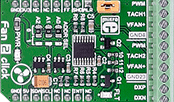
|
|
Fan 2 click carries the MAX31760 precision fan-speed controller. It can measure temperature and adjust the fan speed to keep the temperature at the same level. Fan 2 click can also control two fans at the same time.
The click is designed to run on either 3.3V or 5V power supply. It communicates with the target microcontroller over I2C interface, with additional functionality provided by the following pins on the mikroBUS™ line: INT, AN, RST, CS. |
|
|
|
 |
|
<< First
< Previous
Next >
|
|

